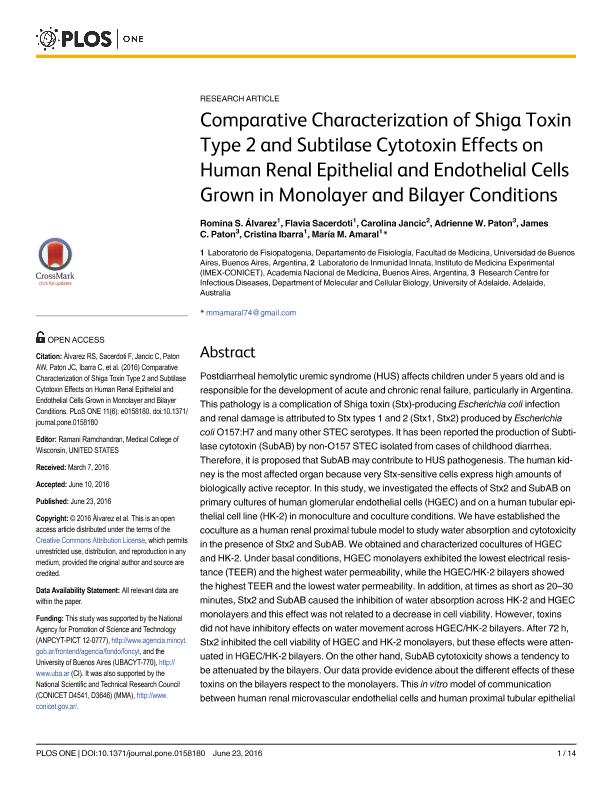Mostrar el registro sencillo del ítem
dc.contributor.author
Alvarez, Romina Soledad

dc.contributor.author
Sacerdoti, Flavia

dc.contributor.author
Jancic, Carolina Cristina

dc.contributor.author
Paton, Adrienne W.
dc.contributor.author
Paton, James C.
dc.contributor.author
Ibarra, Cristina Adriana

dc.contributor.author
Amaral, María Marta

dc.date.available
2018-05-30T16:57:07Z
dc.date.issued
2016-06-23
dc.identifier.citation
Alvarez, Romina Soledad; Sacerdoti, Flavia; Jancic, Carolina Cristina; Paton, Adrienne W.; Paton, James C.; et al.; Comparative Characterization of Shiga Toxin Type 2 and Subtilase Cytotoxin Effects on Human Renal Epithelial and Endothelial Cells Grown in Monolayer and Bilayer Conditions; Public Library of Science; Plos One; 11; 6; 23-6-2016; 1-14; e0158180
dc.identifier.uri
http://hdl.handle.net/11336/46636
dc.description.abstract
Postdiarrheal hemolytic uremic syndrome (HUS) affects children under 5 years old and is responsible for the development of acute and chronic renal failure, particularly in Argentina. This pathology is a complication of Shiga toxin (Stx)-producing Escherichia coli infection and renal damage is attributed to Stx types 1 and 2 (Stx1, Stx2) produced by Escherichia coli O157:H7 and many other STEC serotypes. It has been reported the production of Subtilase cytotoxin (SubAB) by non-O157 STEC isolated from cases of childhood diarrhea. Therefore, it is proposed that SubAB may contribute to HUS pathogenesis. The human kidney is the most affected organ because very Stx-sensitive cells express high amounts of biologically active receptor. In this study, we investigated the effects of Stx2 and SubAB on primary cultures of human glomerular endothelial cells (HGEC) and on a human tubular epithelial cell line (HK-2) in monoculture and coculture conditions. We have established the coculture as a human renal proximal tubule model to study water absorption and cytotoxicity in the presence of Stx2 and SubAB. We obtained and characterized cocultures of HGEC and HK-2. Under basal conditions, HGEC monolayers exhibited the lowest electrical resistance (TEER) and the highest water permeability, while the HGEC/HK-2 bilayers showed the highest TEER and the lowest water permeability. In addition, at times as short as 20–30 minutes, Stx2 and SubAB caused the inhibition of water absorption across HK-2 and HGEC monolayers and this effect was not related to a decrease in cell viability. However, toxins did not have inhibitory effects on water movement across HGEC/HK-2 bilayers. After 72 h, Stx2 inhibited the cell viability of HGEC and HK-2 monolayers, but these effects were attenuated in HGEC/HK-2 bilayers. On the other hand, SubAB cytotoxicity shows a tendency to be attenuated by the bilayers. Our data provide evidence about the different effects of these toxins on the bilayers respect to the monolayers. This in vitro model of communication between human renal microvascular endothelial cells and human proximal tubular epithelial cells is a representative model of the human proximal tubule to study the effects of Stx2 and SubAB related to the development of HUS.
dc.format
application/pdf
dc.language.iso
eng
dc.publisher
Public Library of Science

dc.rights
info:eu-repo/semantics/openAccess
dc.rights.uri
https://creativecommons.org/licenses/by/2.5/ar/
dc.subject
Shiga Toxin
dc.subject
Subtilase Cytotoxin
dc.subject
Endothelial Renal Cell
dc.subject
Epithelial Renal Cell
dc.subject.classification
Enfermedades Infecciosas

dc.subject.classification
Ciencias de la Salud

dc.subject.classification
CIENCIAS MÉDICAS Y DE LA SALUD

dc.title
Comparative Characterization of Shiga Toxin Type 2 and Subtilase Cytotoxin Effects on Human Renal Epithelial and Endothelial Cells Grown in Monolayer and Bilayer Conditions
dc.type
info:eu-repo/semantics/article
dc.type
info:ar-repo/semantics/artículo
dc.type
info:eu-repo/semantics/publishedVersion
dc.date.updated
2018-05-28T14:47:45Z
dc.identifier.eissn
1932-6203
dc.journal.volume
11
dc.journal.number
6
dc.journal.pagination
1-14; e0158180
dc.journal.pais
Estados Unidos

dc.journal.ciudad
San Francisco
dc.description.fil
Fil: Alvarez, Romina Soledad. Consejo Nacional de Investigaciones Científicas y Técnicas. Oficina de Coordinación Administrativa Houssay. Instituto de Fisiología y Biofísica Bernardo Houssay. Universidad de Buenos Aires. Facultad de Medicina. Instituto de Fisiología y Biofísica Bernardo Houssay; Argentina. Universidad de Buenos Aires. Facultad de Medicina. Departamento de Ciencias Fisiológicas. Laboratorio de Fisiopatogenia; Argentina
dc.description.fil
Fil: Sacerdoti, Flavia. Consejo Nacional de Investigaciones Científicas y Técnicas. Oficina de Coordinación Administrativa Houssay. Instituto de Fisiología y Biofísica Bernardo Houssay. Universidad de Buenos Aires. Facultad de Medicina. Instituto de Fisiología y Biofísica Bernardo Houssay; Argentina. Universidad de Buenos Aires. Facultad de Medicina. Departamento de Ciencias Fisiológicas. Laboratorio de Fisiopatogenia; Argentina
dc.description.fil
Fil: Jancic, Carolina Cristina. Consejo Nacional de Investigaciones Científicas y Técnicas. Instituto de Medicina Experimental. Academia Nacional de Medicina de Buenos Aires. Instituto de Medicina Experimental; Argentina
dc.description.fil
Fil: Paton, Adrienne W.. University of Adelaide; Australia
dc.description.fil
Fil: Paton, James C.. University of Adelaide; Australia
dc.description.fil
Fil: Ibarra, Cristina Adriana. Consejo Nacional de Investigaciones Científicas y Técnicas. Instituto de Medicina Experimental. Academia Nacional de Medicina de Buenos Aires. Instituto de Medicina Experimental; Argentina. Universidad de Buenos Aires. Facultad de Medicina. Departamento de Ciencias Fisiológicas. Laboratorio de Fisiopatogenia; Argentina
dc.description.fil
Fil: Amaral, María Marta. Consejo Nacional de Investigaciones Científicas y Técnicas. Instituto de Medicina Experimental. Academia Nacional de Medicina de Buenos Aires. Instituto de Medicina Experimental; Argentina. Universidad de Buenos Aires. Facultad de Medicina. Departamento de Ciencias Fisiológicas. Laboratorio de Fisiopatogenia; Argentina
dc.journal.title
Plos One

dc.relation.alternativeid
info:eu-repo/semantics/altIdentifier/doi/https://doi.org/10.1371/journal.pone.0158180
dc.relation.alternativeid
info:eu-repo/semantics/altIdentifier/url/http://journals.plos.org/plosone/article?id=10.1371/journal.pone.0158180
Archivos asociados
